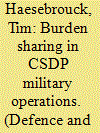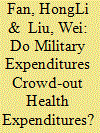|
|
|
Sort Order |
|
|
|
Items / Page
|
|
|
|
|
|
|
| Srl | Item |
| 1 |
ID:
162546


|
|
|
|
|
| Summary/Abstract |
This paper examines the security relationship between the US and Europe, focusing on potential spillin effects of US military expenditures on European demand for military expenditures during the early twenty-first century. The goal is to test whether or not European states view US expenditures as a complement or as a substitute to their own military expenditures. Past work in this area has found mixed results concerning the effect of US military expenditures, but focus strictly on the spillins within a formal alliance, specifically NATO, and use a time series dominated by Cold War dynamics. This study differentiates itself by accounting for both US total military expenditures and its regional expenditures through incorporation of US military base and personnel deployments across Europe. Additionally, this paper uses government revenue in its estimation to mitigate potential endogeneity. Findings using Arellano–Bond dynamic panel analysis suggest that there is a strong probability of substitution among European states.
|
|
|
|
|
|
|
|
|
|
|
|
|
|
|
|
| 2 |
ID:
162547


|
|
|
|
|
| Summary/Abstract |
Military burden sharing has been a subject of repeated debates in NATO and the UN. Despite more modest goals, the European Union’s (EU) Common Security and Defense Policy (CSDP) has experienced no fewer difficulties in garnering men, money, and materiel. While this may not come as a surprise, the fact that some EU member states have carried disproportionate shares of the burden of CSDP operations is a puzzle that remains unaccounted for. We address this gap by analyzing determinants of contribution levels to CSDP operations. In employing an innovative multi-method design that combines insights from collection action theory with those from integrated theories of military burden sharing, our results indicate that EU countries tend to contribute in positive disproportion with their capabilities when they have a strong peacekeeping tradition and elections are distant. In contrast, they undercontribute when small trade volumes with the area of operations combine with a weak peacekeeping tradition.
|
|
|
|
|
|
|
|
|
|
|
|
|
|
|
|
| 3 |
ID:
162554


|
|
|
|
|
| Summary/Abstract |
Anecdotal evidence offers conflicting views on the impact of globalisation on military expenditure. We contribute to the existing literature by investigating the effect of globalisation on military expenditure in 82 countries for the period, 1989–2012. After introducing economic and strategic variables into the model, we utilise the dynamic panel generalised method of moments system to estimate the relationship in the variables. The empirical findings reveal that globalisation reduces both military burden and real military expenditure. The findings are consistent, irrespective of the globalisation indicator adopted. The policy implications of the results are explained.
|
|
|
|
|
|
|
|
|
|
|
|
|
|
|
|
| 4 |
ID:
162548


|
|
|
|
|
| Summary/Abstract |
The paper examines the relationship between health and military expenditures using pooled cross-sectional (197 countries) and time series (2000–2013) data. Simultaneous equation models were employed to estimate the relationship between an array of public sector expenditures in order to address potential endogeneity. Our empirical findings strongly support the crowding-out hypothesis whereby increased military expenditures reduce the capacity of government to direct expenditures to health expenditures. These findings were robust to alternative specifications explored in the sensitivity analyses. Compared with upper-middle-income countries, the crowding-out effect became more pronounced among lower-middle-income countries. Consequently, this study shows that increased military expenditures negatively impacts health expenditures, and therefore poses as an important risk factor for population health and individual well-being. Moreover, it is the poorest of nations that are most sensitive to the negative effects of increased military expenditures.
|
|
|
|
|
|
|
|
|
|
|
|
|
|
|
|
| 5 |
ID:
162549


|
|
|
|
|
| Summary/Abstract |
This study investigates the association between defense and health spending using multi-resolution analysis incorporating the structural change model. Our empirical results suggested that a negative correlation between defense and health spending persists over the entire period of 1941–2013 in the very long-run (over 16 years cycle), but there is a change in correlation between defense and health spending in the short-run (2–4 years cycle), medium-run (4–8 years cycle), and long-run (8–16 years cycle) during the same period. In particular, there appears to have been a trade-off relationship between defense and health spending during the ex-Korean War period, but there was a complementary relationship between defense and health spending during the post-Korean War period. The crowding-out effect of health spending on defense spending during the period when the Affordable Care Act was put into effect relies on the strength of the positive correlation in the long-run (8–16 years cycle) and negative correlation in the short-run (2–4 years cycle) and very long-run (over 16 years cycle).
|
|
|
|
|
|
|
|
|
|
|
|
|
|
|
|
| 6 |
ID:
162550


|
|
|
|
|
| Summary/Abstract |
This study estimates a three-sector Feder–Ram model using US annual data for 1965–2014 to confirm the externality of defense expenditure in the United States. Although the model is often used in the literature to scrutinize whether this effect exists, a flaw intrinsic to this model is the appearance of multicollinearity. In this study, I introduced novel techniques, namely: the standardization and estimation of a simple slope, to estimate the model. The results are as follows. First, I prove that the multicollinearity problem can be resolved by standardization. Second, externality, which is judged to conventionally exist, is not found. Third, increases in defense expenditure bring about positive but limited economic growth when the ratio of private to defense expenditure in the previous year ranges from 5.09 to 6.82%. By re-estimating the model, this study contributes to developing the Feder–Ram model within the related literature.
|
|
|
|
|
|
|
|
|
|
|
|
|
|
|
|
| 7 |
ID:
162551


|
|
|
|
|
| Summary/Abstract |
This study examines the causal nexus between defence spending and education expenditure in China using the bootstrap Granger full-sample causality test and sub-sample rolling window estimation. The full-sample result indicates that there is no causality between defence spending and education expenditure. By adopting a time-varying rolling window approach to revisit the dynamic causal relationships, this article identifies a negative unidirectional causality running from education expenditure to defence spending. The finding suggests that it is the education expenditure crowds out defence spending in China rather than reverse. No causality is demonstrated from defence spending to education expenditure, indicating that an increase in military spending will not crowd out expenditure on education. The results could be partly explained by that the education expenditure in China is below the requirement of corresponding economic growth, urging for more financial budget. Whereas the findings support a negative trade-off between defence and education expenditures, they refute the theory of ‘guns for butter’.
|
|
|
|
|
|
|
|
|
|
|
|
|
|
|
|
| 8 |
ID:
162553


|
|
|
|
|
| Summary/Abstract |
This paper offers a simple strategic framework to help governments identify various policy mechanisms to minimize public sector corruption. The paper offers a formal model that blends the economics of crime with identity economics and money laundering. It presents a partial equilibrium framework that focuses on a representative public official engaged in a mix of legal and illegal effort. The model introduces various levers a government might use to impact the costs and benefits of illegal effort. The ultimate goal is to help turn volatile vicious cycles of political instability, into steady virtuous cycles of stability, growth, and sustainable development.
|
|
|
|
|
|
|
|
|
|
|
|
|
|
|
|
| 9 |
ID:
162552


|
|
|
|
|
| Summary/Abstract |
This paper examines the generation of technological knowledge by leading companies in the defence industry. In particular, we test whether the characteristics of large defence companies are related to both the production of different types of patents (civilian, military and mixed), and the generation of dual-use technologies. To explore these links, we rely on economic data for the top 100 defence companies from the Stockholm International Peace Research Institute database, and patent information from the Worldwide Patent Statistical Database. Our results show that the relationship between the production of civilian patents and the size of the company is positive and significant. However, this relationship does not hold for the production of military patents. Furthermore, the military commercial profile is unrelated to the generation of military patents. Regarding the involvement in dual-use technologies, firms engaged in dual-use are those with higher military sales, a greater number of employees and a larger number of patents (civilian, military and mixed) than those not engaged in dual-use. Furthermore, we found a skill effect (more involvement in dual-use per employee) in European firms compared to US firms. These findings help to identify which firms should be targeted by government policies if increasing dual-use technologies becomes a political objective.
|
|
|
|
|
|
|
|
|
|
|
|
|
|
|
|
| 10 |
ID:
162555


|
|
|
|
|
| Summary/Abstract |
This paper examines the nexus between the Japanese strategy and economic–industrial mobilization during the period 1937–1945. From 1937 to December 1941, the country was engaged in a land war of attrition in China. This war requested an immense amount of resources and was associated with armaments procurement strategy with emphasis in the army. However, the Japanese strategic vision assumed that the state was strong enough to engage in one land war against China and in a naval war in the Pacific simultaneously. The basis of Japanese strategy was a utopia. Making things worse, the naval war in the Pacific was conducted against the most industrialized powers in the world [the US and the British Empire (Britain, Australia, India, etc.)]. Finally, the internal Japanese industrial mobilization was associated with immense errors in armaments production (absence of economies of scale and scope, limited raw materials, etc.). Under these circumstances, the defeat was an expected outcome.
|
|
|
|
|
|
|
|
|
|
|
|
|
|
|
|
|
|
|
|
|